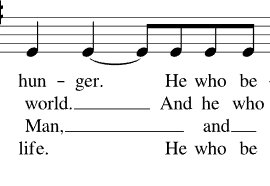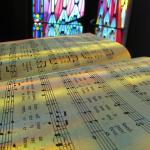Here’s another hymn that, were I given the chance, I would pay good money to ban forever.
This one is different than “Woman of the Night,” or whatever it’s called. It’s from a sub-genre of hymnody that I like to call Catholic Boomer Hymns,” and I should mention first off that the text of this hymn is superb, because it is largely taken from the wonderful John 6, with the final stanza based on John 11. But that’s also a problem, because you can’t write an effective hymn without some sense of poetry and meter, and you certainly can’t pick a few lines out of Holy Scripture or anywhere else and assume they’re going to fit together coherently enough to make into passable poetry.
In most hymnals, if you find the tune name, usually written in a small, all caps font, underneath there will be a series of numbers. For instance, under HYFRYDOL, regardless of the hymn text paired with it, you will find 8.7.8.7. That essentially refers to the number of syllables in each line. Each stanza uses exactly the same number of syllables, so they all fit with the tune as it’s written.
There are hymns that don’t follow the meter strictly, and instead of a series of numbers, you will find the word “Irregular.” For instance, the tune GRAND ISLE, paired with “I Sing a Song of the Saints of God” has a slightly different number of syllables in various lines in each stanza. This can be confusing, but most of them are arranged in a way that makes sense phonetically. The emphases are in the logical places. It’s no masterpiece of hymnody, but it can be learned and sung intuitively.
Not so with “I Am the Bread of Life.” It’s not just Irregular, it’s nonsensically Irregular. It’s so Irregular it needs a pocketful of Metamucil gummies.
Some stanzas begin on the downbeat of the first measure, others on an anacrusis.
Notes are written on top of each other, making it more of a puzzle that has to be solved.
There are large spaces between syllables in some stanzas so that jumbled syllables can be inserted square-peg-in-round-hole style in others.
You may be thinking, “Yeah, well, I don’t care, since I can’t read music anyway.” I understand. The problem is that this is difficult for even trained musicians to read on the fly. So it’s essentially impossible for untrained musicians to catch without literally hundreds of repetitions. It just doesn’t work as a congregational hymn. At least one hymnal includes above the stanzas the words “Leader or All.” That defeats the whole purpose of hymnody. Hymns are meant to be sung together. If it can’t be sung together, it should be a choral anthem, except the disjunct patter of syllables makes it a bad choice for that, as well.
Here’s what one (author unknown) individual came up with.
Oh, and the refrain. The melody is campy, but it’s not unsingably bad. I could quibble with the bad partwriting on the third line, but that’s not unforgiveable. The problem with the refrain is the series of rests followed by three eighth notes on the words, “And I will.”
Let me tell you what’s going to happen here. Congregations aren’t going to release the previous note on time, so it’s going to bleed over into the quarter rest. Then they’re going to rest longer than the quarter rest indicates, anyway. And so, at best, you are going to hear this from the congregation:
-I will raise you up,
-sYOU up,
-RAISE you up
on the last day.
And that might be fine for some of you. Maybe those sad Catholic churches where the congregation doesn’t sing anyway. But if you care about congregational singing, as I hope you all do, you won’t choose this hymn. I hope you will read and meditate on John 6 whenever it comes up in your lectionary or Bible study or any other time. But this isn’t a good hymn. So please take my money and ban it for all eternity.
















